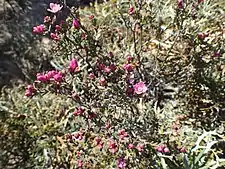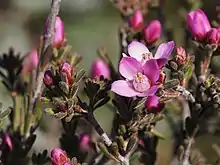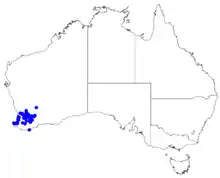Boronia capitata
Boronia capitata, commonly known as the cluster boronia,[2] is a plant in the citrus family, Rutaceae and is endemic to the south-west of Western Australia. It is a slender, spreading shrub with simple leaves and pink, four-petalled flowers.

| Cluster boronia | |
|---|---|
 | |
| Boronia capitata near Quairading | |
| Scientific classification | |
| Kingdom: | Plantae |
| Clade: | Tracheophytes |
| Clade: | Angiosperms |
| Clade: | Eudicots |
| Clade: | Rosids |
| Order: | Sapindales |
| Family: | Rutaceae |
| Genus: | Boronia |
| Species: | B. capitata |
| Binomial name | |
| Boronia capitata | |
 | |
| Occurrence data from Australasian Virtual Herbarium | |
Description
Boronia capitata is a slender, spreading shrub that grows to a height of 15–130 cm (6–50 in). It has simple, thick, linear to club-shaped leaves 4–15 mm (0.2–0.6 in) long. The flowers are pink and are arranged in clusters on the ends of the branches, each on a pedicel 1–3 mm (0.04–0.1 in) long. The four sepals are broadly elliptic to narrow triangular, and the four petals are broadly elliptic, about 6 mm (0.2 in) long.[2][3][4][5]
Taxonomy and naming
Boronia capitata was first formally described in 1863 by George Bentham and the description was published in Flora Australiensis from a specimen collected by James Drummond.[4][6] The specific epithet (capitata) is a Latin word meaning "having a head".[7]
In 1971, Paul G. Wilson described three subspecies:[8]
- Boronia capitata subsp. capitata has leaves and sepals that are glabrous or fringed with hairs and flowers from September to October;[9]
- Boronia capitata subsp. clavata has thick leaves covered with long, soft hairs, and broadly elliptic sepals fringed with hairs and flowers from April to October;[10]
- Boronia capitata subsp. gracilis slender leaves covered with long, soft hairs and narrow egg-shaped sepals with a hairy fringe and flowers from June to November.[11]
Distribution and habitat
Conservation
Subspecies clavata is classified as "not threatened"[13] but subspecies gracilis is classified as "Priority Three" by the Government of Western Australia Department of Parks and Wildlife[14] meaning that it is poorly known and known from only a few locations but is not under imminent threat.[15] Subspecies capitata is listed as "endangered" under the Australian Government Environment Protection and Biodiversity Conservation Act 1999[16] and as "Threatened Flora (Declared Rare Flora — Extant)" by the Department of Environment and Conservation (Western Australia).[12] The main threats to this subspecies are clearing and fragmentation of its habitat.[16]
References
- "Boronia capitata". Australian Plant Census. Retrieved 4 March 2019.
- "Boronia capitata". FloraBase. Western Australian Government Department of Parks and Wildlife.
- Duretto, Marco F.; Wilson, Paul G.; Ladiges, Pauline Y. "Boronia capitata". Australian Biological Resources Study, Department of the Environment and Energy, Canberra. Retrieved 5 March 2019.
- Bentham, George; von Mueller, Ferdinand (1863). Flora Australiensis (Volume 1). London: Lovell Reeve and Co. p. 323. Retrieved 4 March 2019.
- Corrick, Margaret G.; Fuhrer, Bruce A. (2009). Wildflowers of southern Western Australia (3rd ed.). Dural, N.S.W.: Rosenberg Publishing. p. 190. ISBN 9781877058844.
- "Boronia capitata". APNI. Retrieved 4 March 2019.
- Brown, Roland Wilbur (1956). The Composition of Scientific Words. Washington, D.C.: Smithsonian Institution Press. p. 399.
- Wilson, Paul G. (1971). "Taxonomic notes on the family Rutaceae, principally of Western Australia". Nuytsia. 1 (2): 202–203. Retrieved 5 March 2019.
- Duretto, Marco F.; Wilson, Paul G.; Ladiges, Pauline Y. "Boronia capitata subsp. capitata". Australian Biological Resources Study, Department of the Environment and Energy, Canberra. Retrieved 5 March 2019.
- Duretto, Marco F.; Wilson, Paul G.; Ladiges, Pauline Y. "Boronia capitata subsp. clavata". Australian Biological Resources Study, Department of the Environment and Energy, Canberra. Retrieved 5 March 2019.
- Duretto, Marco F.; Wilson, Paul G.; Ladiges, Pauline Y. "Boronia capitata subsp. gracilis". Australian Biological Resources Study, Department of the Environment and Energy, Canberra. Retrieved 5 March 2019.
- "Boronia capitata subsp. capitata". FloraBase. Western Australian Government Department of Parks and Wildlife.
- "Boronia capitata subsp. clavata". FloraBase. Western Australian Government Department of Parks and Wildlife.
- "Boronia capitata subsp. gracilis". FloraBase. Western Australian Government Department of Parks and Wildlife.
- "Conservation codes for Western Australian Flora and Fauna" (PDF). Government of Western Australia Department of Parks and Wildlife. Retrieved 5 March 2019.
- "Approved Conservation Advice for Boronia capitata subsp. capitata" (PDF). Australian Government Department of the Environment. Retrieved 20 March 2019.